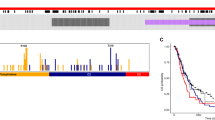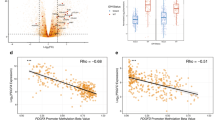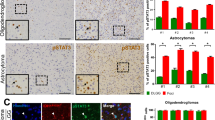Abstract
MMAC1, also known as PTEN or TEP-1, was recently identified as a gene commonly mutated in a variety of human neoplasias. Sequence analysis revealed that MMAC1 harbored sequences similar to those found in several protein phosphatases. Subsequent studies demonstrated that MMAC1 possessed in vitro enzymatic activity similar to that exhibited by dual specificity phosphatases. To characterize the potential cellular functions of MMAC1, we expressed wild-type and several mutant variants of MMAC1 in the human glioma cell line, U373, that lacks endogenous expression. While expression of wild-type MMAC1 in these cells significantly reduced their growth rate and saturation density, expression of enzymatically inactive MMAC1 significantly enhanced growth in soft agar. Our observations indicate that while wild-type MMAC1 exhibits activities compatible with its proposed role as a tumor suppressor, cellular expression of MMAC1 containing mutations in the catalytic domain may yield protein products that enhance transformation characteristics.
This is a preview of subscription content, access via your institution
Access options
Subscribe to this journal
Receive 50 print issues and online access
$259.00 per year
only $5.18 per issue
Buy this article
- Purchase on Springer Link
- Instant access to full article PDF
Prices may be subject to local taxes which are calculated during checkout



Similar content being viewed by others
References
Baker BW, Boettiger D, Spooner E and Norton JD. . 1992 Nuc. Acids Res. 20: 5234.
Cheney IW, Johnson DE, Vaillancourt M-T, Avanzini J, Morimoto A, Demers WG, Wills KN, Shabram PW, Bolen JB, Tavtigian SV and Bookstein R. . 1998 Cancer Res. 58: 2331–2334.
Furnari FB, Lin H, Su Huang H-J and Cavenee WK. . 1997 Proc. Natl. Acad. Sci. USA 94: 12479–12484.
Guldgerg P, Straten P-T, Birck A, Ahrenkiel V, Kirkin AF and Zeuthen J. . 1997 Cancer Res. 57: 3660–3663.
Kong D, Suzuki A, Zou T-T, Sakurada A, Kemp LW, Wakatsuki S, Yokohama T, Yamakawa H, Furukawa T, Sato S, Yin J, Wang S, Abraham JM, Souza RF, Smolinski KN, Meltzer SJ and Horii A. . 1998 Nature Genet. 17: 143–144.
Liaw D, Marsh DJ, Li J, Dahia PLM, Wang SI, Zheng Z, Bose S, Call KM, Tsou HC, Peacocke M, Eng C and Parsons R. . 1997 Nature Genet. 16: 64–67.
Li D-M and Sun H. . 1997 Cancer Res. 57: 2124–2129.
Li J, Yen C, Liaw D, Podsypanina K, Bose S, Wang SI, Puc J, Miliaresis C, Rodgers L, McCombie R, Bigner SH, Giovanella BC, Ittman M, Tycko B, Hibshoosh H, Wigler MH and Parsons R. . 1997 Science 275: 1943–1947.
Marsh DJ, Dahia PLM, Zheng Z, Liaw D, Parsons R, Gorlin RJ and Eng C. . 1997 Nat. Genet. 16: 333–334.
Myers MP, Stolarov JP, Eng C, Li J, Wang SI, Wigler MH, Parsons R and Tonks NK. . 1998 Proc. Natl. Acad. Sci. USA 94: 9052–9057.
Neel BG and Tonks NK. . 1997 Curr. Opin. Cell Biol. 9: 193–204.
Onishi M, Kinoshita S, Morikawa Y, Shibuya A, Phillips J, Lanier LL, Gorman DM, Nolan GP, Miyajima A and Kitamura T. . 1997 Exp. Hematol. 24: 324–329.
Pawson T and Scott JD. . 1997 Science 278: 2075–2080.
Pullen N, Dennis PB, Andjelkovic M, Dufner A, Kozma SC, Hemmings BA and Thomas G. . 1998 Science 279: 707–710.
Saras J and Heldin C-H. . 1996 Trends in Bioch. Sci. 21: 455–457.
Shiozaki K and Russell P. . 1995 Nature 378: 739–743.
Steck PA, Pershouse MA, Jasser SA, Yung WKA, Lin H, Ligon AH, Langford LA, Baumgard ML, Hattier T, Davis T, Frye C, Hu R, Swelund B, Teng DHF and Tavtigian SV. . 1997 Nature Genet. 15: 356–362.
Stephens L, Anderson K, Stokoe D, Erdjument-Bromage H, Painter GF, Holmes AB, Gaffney PRJ, Reese CB, McCormick F, Tempst P, Coadwell J and Hawkins PT. . 1998 Science 279: 710–714.
Sun H, Charles CH, Lau LF and Tonks NK. . 1993 Cell 75: 487–493.
Tamura M, Gu J, Marsumoto K, Aota S, Parsons R and Yamada KM. . 1998 Science 280: 1614–1617.
Teng DH-F, Hu R, Lin H, Davis T, Iliev D, Frye C, Swedlund B, Hansen KL, Vinson VL, Gumpper KL, Ellis L, El-Naggar A, Frazier M, Jasser S, Langford LA, Lee J, Mills GB, Pershouse MA, Pollack RE, Tornos C, Troncosco P, Yung WKA, Fujii G, Berson A, Bookstein R, Bolen JB, Tavtigian SV and Steck PA. . 1997 Cancer Res. 57: 5221–5225.
Acknowledgements
We thank B Wu, C Young and J Sheung for generating purified recombinant MMAC1 protein. We would also like to thank J-H Her, A Mui, D Parry, M Tomlinson, D Woods, R Herbst and M McMahon for reagents and very helpful suggestions. The DNAX Research Institute is supported by the Schering-Plough Corporation.
Author information
Authors and Affiliations
Rights and permissions
About this article
Cite this article
Morimoto, A., Berson, A., Fujii, G. et al. Phenotypic analysis of human glioma cells expressing the MMAC1 tumor suppressor phosphatase. Oncogene 18, 1261–1266 (1999). https://doi.org/10.1038/sj.onc.1202441
Received:
Revised:
Accepted:
Published:
Issue Date:
DOI: https://doi.org/10.1038/sj.onc.1202441
Keywords
This article is cited by
-
Involvement of Akt/NF-κB pathway in antitumor effects of parthenolide on glioblastoma cells in vitro and in vivo
BMC Cancer (2012)
-
Silencing mammalian target of rapamycin signaling by small interfering RNA enhances rapamycin-induced autophagy in malignant glioma cells
Oncogene (2007)
-
The human tumour suppressor PTEN regulates longevity and dauer formation in Caenorhabditis elegans
Oncogene (2005)
-
PTEN/MMAC1 expression in melanoma resection specimens
British Journal of Cancer (2002)
-
Motif analysis of the tumor suppressor gene MMAC/PTEN identifies tyrosines critical for tumor suppression and lipid phosphatase activity
Oncogene (2002)



